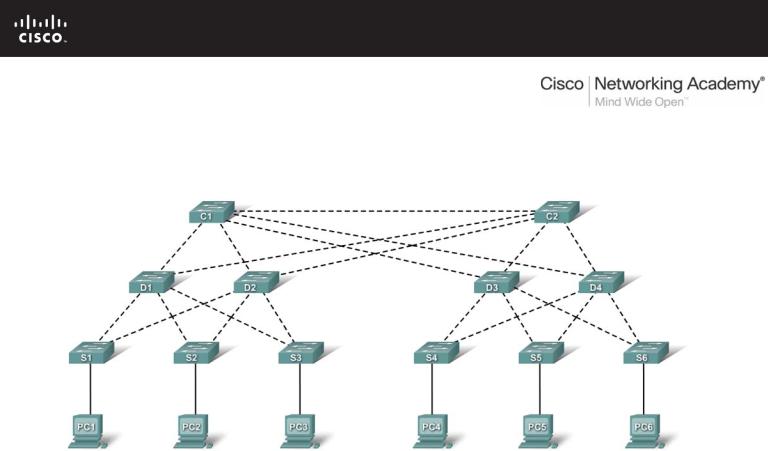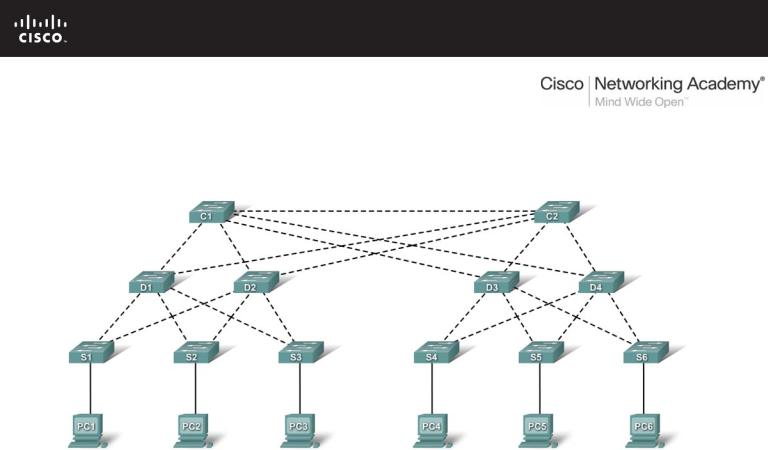
- •PT Activity 1.2.4: Build a Hierarchical Topology
- •PT Activity 1.3.1: Review of Concepts from Exploration 1
- •PT Activity 1.3.2: Review of Concepts from Exploration 1 - Challenge
- •PT Activity 1.3.3: Troubleshooting a Small Network
- •PT Activity 1.4.1: Packet Tracer Skills Integration Challenge
- •PT Activity 2.3.8: Configuring Basic Switch Management
- •PT Activity 2.4.7: Configure Switch Security
- •PT Activity 2.5.1: Basic Switch Configuration
- •PT Activity 2.6.1: Packet Tracer Skills Integration Challenge
- •PT Activity 3.1.4: Investigating a VLAN Implementation
- •PT Activity 3.2.3: Investigating VLAN Trunks
- •PT Activity 3.3.4: Configuring VLANs and Trunks
- •PT Activity 3.4.2: Troubleshooting a VLAN Implementation
- •PT Activity 3.5.1: Basic VLAN Configuration
- •PT Activity 3.5.2: Challenge VLAN Configuration
- •PT Activity 3.5.3: Troubleshooting VLAN Configurations
- •PT Activity 3.6.1: Packet Tracer Skills Integration Challenge
- •PT Activity 4.3.3: Configure VTP
- •PT Activity 4.4.1: Basic VTP Configuration
- •PT Activity 4.4.2: Challenge VTP Configuration
- •PT Activity 4.4.3: Troubleshooting the VTP Configuration
- •PT Activity 4.5.1: Packet Tracer Skills Integration Challenge
- •PT Activity 5.1.3: Examining a Redundant Design
- •PT Activity 5.2.5: Configuring STP
- •PT Activity 5.5.2: Challenge Spanning Tree Protocol
- •PT Activity 5.5.3: Troubleshooting Spanning Tree Protocol
- •PT Activity 5.6.1: Packet Tracer Skills Integration Challenge
- •PT Activity 6.2.2.4: Configuring Traditional Inter-VLAN Routing
- •PT Activity 6.2.2.5: Configuring Router-on-a-Stick Inter-VLAN Routing
- •PT Activity 6.3.3: Troubleshooting Inter-VLAN Routing
- •PT Activity 6.4.1: Basic Inter-VLAN Routing
- •PT Activity 6.4.2: Challenge Inter-VLAN Routing
- •PT Activity 6.4.3: Troubleshooting Inter-VLAN Routing
- •PT Activity 6.5.1: Packet Tracer Skills Integration Challenge
- •PT Activity 7.3.2: Configuring Wireless LAN Access
- •PT Activity 7.5.2: Challenge Wireless WRT300N
- •PT Activity 7.5.3: Troubleshooting Wireless WRT300N
- •PT Activity 7.6.1: Packet Tracer Skills Integration Challenge

PT Activity 5.1.3: Examining a Redundant Design
Topology Diagram
Learning Objectives
•Check for STP convergence.
•Examine the ARP process.
•Test redundancy in a switched network.
Introduction
This activity opens with completion at 100%. The purpose of the activity is to observe how STP operates by default. Switches have been added to the network "out of the box." Cisco switches can be connected to a network without any additional action required by the network administrator. For the purpose of this lab, the bridge priority was modified.
Task 1: Check for STP Convergence
When STP is fully converged, the following conditions exist:
•All PCs have green link lights on the switched ports.
•Access layer switches have one forwarding uplink (green) to a distribution layer switch and a blocking uplink (amber) to a second distribution layer switch.
•Distribution layer switches have one forwarding uplink (green) to a core layer switch and a blocking uplink (amber) to another core layer switch.
All contents are Copyright © 1992–2007 Cisco Systems, Inc. All rights reserved. This document is Cisco Public Information. |
Page 1 of 3 |

CCNA Exploration |
|
LAN Switching and Wireless: STP |
PT Activity 5.1.3: Examining a Redundant Design |
Task 2: Examine the ARP Process
Step 1. Switch to Simulation mode.
Step 2. Ping from PC1 to PC6.
Use the Add Simple PDU tool to create a PDU from PC1 to PC6. Be sure ARP and ICMP are selected in the Event List Filters. Click Capture/Forward to examine the ARP process as the switched network learns the MAC addresses of PC1 and PC6. Notice that all possible loops are stopped by blocking ports. For example, the ARP request from PC1 travels from S1 to D2 to C1 to D1 and then back to S1. However, because STP is blocking the link between S1 and D1, no loop occurs.
Notice that the ARP reply from PC6 travels back along one path. Why?
________________________________________________________________________________
________________________________________________________________________________
________________________________________________________________________________
Record the loop-free path between PC1 and PC6.
________________________________________________________________________________
________________________________________________________________________________
Step 3. Examine the ARP process again.
Click New under the Scenario 0 dropdown box to create Scenario 1. Examine the ARP process again by pinging between two different PCs.
What part of the path changed from the last set of pings?
________________________________________________________________________________
________________________________________________________________________________
Task 3: Test Redundancy in a Switched Network
Step 1. Delete the link between S1 and D2.
Switch to Realtime mode. Delete the link between S1 and D2. It takes some time for STP to converge and establish a new, loop-free path. Because only S1 is affected, watch for the amber light on the link between S1 and D1 to change to green.
Step 2. Ping between PC1 and PC6.
After the link between S1 and D1 is active (indicated by a green light), switch to Simulation mode and create Scenario 2. Ping between PC1 and PC6 again.
Record the new loop-free path.
________________________________________________________________________________
________________________________________________________________________________
Step 3. Delete link between C1 and D3.
Switch to Realtime mode. Notice that the links between D3 and D4 to C2 are amber. Delete the link between C1 and D3. It will take some time for STP to converge and establish a new, loop-free path. Watch the amber links on D3 and D4. You can switch between Simulation mode and Realtime mode to accelerate the process.
Which link is now the active link to C2?
All contents are Copyright © 1992–2007 Cisco Systems, Inc. All rights reserved. This document is Cisco Public Information. |
Page 2 of 3 |

CCNA Exploration |
|
LAN Switching and Wireless: STP |
PT Activity 5.1.3: Examining a Redundant Design |
________________________________________________________________________________
________________________________________________________________________________
Step 4. Ping between PC1 and PC6.
Switch to Simulation mode and create Scenario 3. Ping between PC1 and PC6. Record the new loop-free path.
________________________________________________________________________________
________________________________________________________________________________
Step 5. Delete D4.
Switch to Realtime mode. Notice that S4, S5, and S6 are all forwarding traffic to D4. Delete D4. It takes some time for STP to converge and establish a new, loop-free path. Watch for the links between S4, S5, and S6 to D3 transition to forwarding (green). All three switches should now be forwarding to D3.
Step 6. Ping between PC1 and PC6.
Switch to Simulation mode and create Scenario 4. Ping between PC1 and PC6. Record the new loop-free path.
________________________________________________________________________________
________________________________________________________________________________
What is unique about the new path that you have not seen before?
________________________________________________________________________________
________________________________________________________________________________
________________________________________________________________________________
Step 7. Delete C1.
Switch to Realtime mode. Notice that D1 and D2 are both forwarding traffic to C1. Delete C1. It takes some time for STP to converge and establish a new, loop-free path. Watch for the links between D1 and D2 to C2 to transition to forwarding (green). Once converged, both switches should now be forwarding to C2.
Step 8. Ping between PC1 and PC6.
Switch to Simulation mode and create Scenario 5. Ping between PC1 and PC6. Record the new loop-free path.
________________________________________________________________________________
________________________________________________________________________________
All contents are Copyright © 1992–2007 Cisco Systems, Inc. All rights reserved. This document is Cisco Public Information. |
Page 3 of 3 |

PT Activity 5.2.5: Configuring STP
Topology Diagram
Learning Objectives
•Examine the STP default state.
•Configure the root bridge.
•Configure the backup root bridge.
•Finalize STP configuration.
Introduction
In this activity, the switches are “out of the box” without any configuration. You will manipulate the root bridge election so that the core switches are chosen before the distribution or access layer switches.
Task 1: Examine the STP Default State
Step 1. Examine link lights.
When STP is fully converged, the following conditions exist:
•All PCs have green link lights on the switched ports.
•Access layer switches have one forwarding uplink (green) to a distribution layer switch and a blocking uplink (amber) to a core layer switch.
•Distribution layer switches have one forwarding uplink (green) to a core layer switch and a blocking uplink (amber) to another core layer switch.
Step 2. Switch to Simulation mode.
Step 3. Determine the root bridge.
Click Capture/Forward. Without looking at BPDU detail, MAC addresses, or the show spanning-tree command, can you tell which switch is the root bridge?
All contents are Copyright © 1992–2007 Cisco Systems, Inc. All rights reserved. This document is Cisco Public Information. |
Page 1 of 3 |

CCNA Exploration |
|
LAN Switching and Wireless: STP |
PT Activity 5.2.5: Configuring STP |
____________________________________________________________________________________
____________________________________________________________________________________
Can you think of a reason why this switch is not a good choice as root?
____________________________________________________________________________________
____________________________________________________________________________________
Task 2: Configure the Root Bridge
Step 1. Configure the root bridge.
One of the core switches should be root, and the other should be the backup root. Switch to Realtime mode and configure C1 with a priority of 4096.
C1(config)#spanning-tree vlan 1 priority 4096
Step 2. Switch between Realtime and Simulation modes.
Switch between Realtime mode and Simulation mode several times until all ports on C1 are green.
Step 3. Switch to Simulation mode.
Step 4. Make sure C1 is the root bridge.
Click Capture/Forward several times to watch configuration BPDUs. C1 should be initiating the propagation of BPDUs.
Step 5. Check results.
Your completion percentage should be 17%. If not, click Check Results to see which required components are not yet completed.
Task 3: Configure the Backup Root Bridge
Step 1. Configure the backup root bridge.
The other core switch serves as a backup root bridge. Switch to Realtime mode and configure C2 with a priority of 8192.
C2(config)#spanning-tree vlan 1 priority 8192
Step 2. Switch between Realtime and Simulation modes.
Switch between Realtime mode and Simulation mode several times until all ports on C2 are green.
Step 3. Examine links attached to C2.
What is unique about the C2 links to the distribution layer switches that you do not see with C1 links?
____________________________________________________________________________________
____________________________________________________________________________________
Step 4. Check results.
Your completion percentage should be 33%. If not, click Check Results to see which required components are not yet completed.
Task 4: Finalize STP Configuration
All contents are Copyright © 1992–2007 Cisco Systems, Inc. All rights reserved. This document is Cisco Public Information. Page 2 of 3

CCNA Exploration |
|
LAN Switching and Wireless: STP |
PT Activity 5.2.5: Configuring STP |
Best practice is to never have an access layer switch become root. You could ensure this by configuring all access layer switches with a priority higher than the default. However, because there are fewer distribution switches, it is more efficient to configure these switches with a slightly higher priority than the backup root switch.
Step 1. Configure distribution switches.
From Realtime mode, configure D1, D2, D3, and D4 with a priority of 12288.
D1(config)#spanning-tree vlan 1 priority 12288
D2(config)#spanning-tree vlan 1 priority 12288
D3(config)#spanning-tree vlan 1 priority 12288
D4(config)#spanning-tree vlan 1 priority 12288
Step 2. Check results.
Your completion percentage should be 100%. If not, click Check Results to see which required components are not yet completed.
All contents are Copyright © 1992–2007 Cisco Systems, Inc. All rights reserved. This document is Cisco Public Information. |
Page 3 of 3 |
